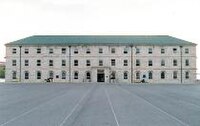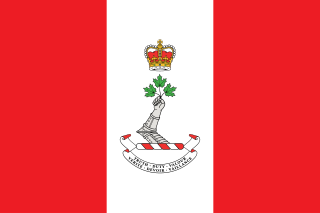
HMCS Stone Frigate [lower-alpha 1] is a dormitory of the Royal Military College of Canada in Kingston, Ontario. Built to be a naval storehouse, it was converted to its present use in 1876 on the establishment of the college.

HMCS Stone Frigate [lower-alpha 1] is a dormitory of the Royal Military College of Canada in Kingston, Ontario. Built to be a naval storehouse, it was converted to its present use in 1876 on the establishment of the college.

The Stone Frigate was originally a storehouse at the Kingston Royal Naval Dockyard, Point Frederick Peninsula, in Kingston, Ontario. Designed by Archibald Fraser in 1819–24, [1] it was constructed under the command of Captain Robert Barrie to store gear and rigging of the British fleet from the War of 1812 which had been dismantled and housed in Navy Bay pursuant to the Rush–Bagot Treaty of 1817. [2]
Closed in 1835, the dockyard reopened in 1837 in response to rebellions in the Canadas. Captain Williams Sandom [3] and a party of sailors resided in the Stone Frigate warehouse close to the St. Lawrence pier in Navy Bay. By the 1860s, only the Stone Frigate storehouse and one wharf of the dockyard were kept in repair. [4]

The former warehouse was converted into a dormitory and classrooms when the Royal Military College of Canada was established in 1876, [5] [6] on the site of the former dockyard.
In 1941, the Royal Military College of Canada cadets were housed in the Stone Frigate while student officers taking Canadian junior war staff courses, field security courses and radio technician's courses were quartered in Fort Frederick. [7]
A plaque erected in 1957 describes the Stone Frigate as follows:
Once part of a large and active naval dockyard, this substantial stone building was erected as a warehouse for naval stores. Although initially planned in 1816, it was not completed until four years later when the need for storage facilities to hold gear and rigging from British warships dismantled in compliance with the Rush–Bagot Agreement had become acute. After the Rebellion of 1837 the building briefly functioned as a barracks for the naval detachment charged with patrolling the lakes. It was then apparently used as a storehouse again. By 1876 the structure, now known as the Stone Frigate, had been refitted to house the newly established Royal Military College of Canada, an institution it continues to serve.
— [6]
Known within Royal Military College of Canada as "The Boat", the Stone Frigate houses 1 Squadron, who in turn call themselves the Stone Frigate Military Academy. Renovations to the Stone Frigate began in the summer of 2003; some interior refinishing had taken place in the mid-1960s, however the overall interior condition of the building was poor. Interior stone walls were restored and cleaned and new structural supports and interior walls were constructed. Windows, doors, and mechanical and electrical services were installed and an annex extension was built. The Department of National Defence officially re-opened the renovated Stone Frigate building in early April 2004. The Stone Frigate is on the Registry of Historic Places of Canada. [8]
Pipe Major Donald M. Carrigan composed the Stone Frigate Reel in honour of the Stone Frigate at the Royal Military College of Canada circa 1983. [9]

The history of the Royal Canadian Navy goes back to 1910, when the naval force was created as the Naval Service of Canada and renamed a year later by King George V. The Royal Canadian Navy (RCN) is one of the three environmental commands of the Canadian Forces. Over the course of its history, the RCN has played a role in the First World War, contributed significantly to the Battle of the Atlantic during the Second World War, and was a part of NATO's force buildup during the Cold War. In 1968, the RCN was amalgamated with the Canadian Army and the Royal Canadian Air Force to form what is today the unified Canadian Armed Forces. The naval force was known as Maritime Command until 2011, when the environmental command was renamed as the Royal Canadian Navy.

The Royal Military College of Canada, abbreviated in English as RMC and in French as CMR, is a military academy and, since 1959, a degree-granting university of the Canadian Armed Forces. It was established in 1874 and conducted its first classes on June 1, 1876. Programs are offered at the undergraduate and graduate levels, both on campus as well as through the college's distance learning program via the Division of Continuing Studies.

The Rush–Bagot Treaty or Rush–Bagot Disarmament was a treaty between the United States and Great Britain limiting naval armaments on the Great Lakes and Lake Champlain, following the War of 1812. It was ratified by the United States Senate on April 16, 1818, and was confirmed by Canada, following Confederation in 1867.

Rear-Admiral Sir Robert Barrie was a British naval officer noted for his service in the War of 1812. He was helped early in his naval career by the patronage of his uncle, Sir Alan Gardner, who arranged for him to take part in the Vancouver Expedition. When the Pacific Coast was explored, he had served as a midshipman with Captain Vancouver in 1791.

HMS St Lawrence was a 102-gun first-rate ship of the line of the Royal Navy that served on Lake Ontario during the War of 1812. Built on the lake at the Royal Navy dockyard in Kingston, Ontario, she was the only Royal Navy ship of the line ever to be launched and operated entirely in fresh water. Constructed in 1814, the ship's arrival on the lake ended all naval action and St Lawrence finished the war having never gone into battle. Following the war, the vessel was laid up, eventually being sold in 1832 to private interests. The ship later sank and is now a recreational dive spot.

HMS Psyche was a 54-gun fourth-rate frigate of the Royal Navy. She was built at the Kingston Royal Naval Dockyard in Kingston, Upper Canada during the War of 1812, using frames shipped from Britain and assembled in Upper Canada. The ship was not completed until after the end of the war in 1815 and did not enter service. Under the Rush–Bagot Treaty of 1816, the frigate was disarmed and laid up at Kingston. The ultimate fate of the ship is unknown.

The Kingston Royal Naval Dockyard was a Royal Navy Dockyard from 1788 to 1853 in Kingston, Ontario, Canada, at the site of the current Royal Military College of Canada.
Penetanguishene Naval Yard was a Royal Navy yard from 1834 to 1856 in Ontario.

Fort Frederick is a historic military building located on Point Frederick on the grounds of the Royal Military College of Canada (RMC) in Kingston, Ontario, Canada. Its construction dates to 1846 and the Oregon boundary dispute. The fort consists of earthworks surrounding a Martello tower. Fort Frederick is included in two separate National Historic Sites of Canada: Kingston Fortifications National Historic Site and the Point Frederick Buildings National Historic Site.
HMS Prince Regent was a 56-gun British warship that served on Lake Ontario during the War of 1812. Prince Regent was built at the Kingston Royal Naval Dockyard in Kingston, Upper Canada and launched on 14 April 1814. Rated as a fourth-rate frigate, Prince Regent took part in the Raid on Fort Oswego in 1814. Following the War of 1812 the frigate was renamed HMS Kingston on 9 December 1814. In 1817, the vessel was placed in reserve following the Rush-Bagot Treaty that demilitarized all the lakes along the United States-Canada border. Discarded in 1832, the vessel found no buyer and sank in Deadman Bay off Kingston after 1832.

Provincial Marine was a coastal protection service in charge of the waters in the Great Lakes, the St. Lawrence River and parts of Lake Champlain under British control. While ships of the Provincial Marine were designated HMS, they were operated in more of a coast guard manner than as a full-fledged navy. Most ships of the Provincial Marine were built on the Great Lakes.
The Royal Naval College of Canada (RNCC) was established by the Department of the Naval Service after the formation of the Royal Canadian Navy (RCN) in 1910. The college was placed under the auspices of the Minister of Naval Service and controlled by the Director of the Naval Service, Rear-Admiral Charles Kingsmill. The initial goal was to train a new generation of Canadian naval officers for the RCN. The college existed from 1911 to 1922 and educated about 150 students until it was closed due to declining numbers and budget cuts by the government of Canada. As the RCN did not have large ships of its own other than HMCS Niobe and HMCS Rainbow, the cadets followed a course of study that would qualify them for eventual service on British warships. The graduated midshipmen were required to serve approximately one year of "big ship duty" as part of their training.
Captain John Moreau Grant CBE was a Canadian naval officer. He was the first Commanding Officer of HMCS Royal Roads in Esquimalt, British Columbia. The Grant Building at Royal Roads University was named in his honour.
Commodore William Prine Hayes CD, ADC was a Canadian Commodore and educator. He served as the Commandant at Royal Military College of Canada from 1967 to 1969. He served as the Commandant at the Royal Roads Military College.

The Royal Military College of Canada Museum, established in 1962, is located in a Martello tower known as Fort Frederick on the campus of the Royal Military College of Canada in Kingston, Ontario, and is operated by the college. Until 2016 the museum had regular hours from the last weekend in June until Labour Day. Although admission was free, donations were accepted. Guided tours were offered in English and French. Genealogical research and archival records services were offered relating to college history or with inquires relating to ex-cadets when permitted by privacy regulations.
Point Frederick is a 41-hectare (101-acre) peninsula in Kingston, Ontario, Canada. The peninsula is located at the south end of the Rideau Canal where Lake Ontario empties into the St. Lawrence River. Point Frederick is bounded by the Cataraqui River to the west, the St. Lawrence River to the south, and Navy Bay to the east. The peninsula is occupied by the Royal Military College of Canada (RMC). Several of the buildings located on Point Frederick and the site of the old naval dockyard are national historic sites. Fort Frederick, at the south end of the peninsula, is a feature of the Kingston Fortifications National Historic Site of Canada.
HMCS Cataraqui is a Canadian Forces Naval Reserve Division (NRD) located in Kingston, Ontario. Dubbed a stone frigate, HMCS Cataraqui is a land-based naval establishment for part-time sailors as well as a local recruitment centre for the Royal Canadian Navy (RCN). It is one of 24 naval reserve divisions located in major cities across Canada.
This is a history of military education in Canada.